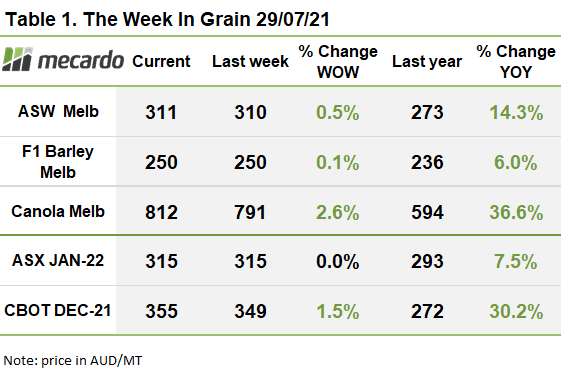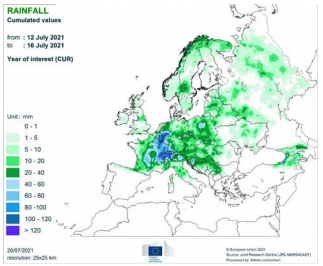We are starting to see some numbers come through from the US Spring Wheat crop tour -and they are not pretty. Scouts finished the tour in North Dakota and reported an average of 28.9bu/ac (~1.9t/ha) compared with the USDA’s 28bu/ac estimate and the 5-year aver-age of 43bu/ac (2.9t/ha). There was no consideration made for paddocks cut for hay or simply abandoned. Scouts also noted excellent test weight and protein - unsurprising in a drought affected crop.
If we use the findings of the US Spring Wheat tour as a surrogate for what is to come in Canada, it draws an equally grim picture. One estimate of a Canadian grain analyst has the national wheat crop not exceeding 35bu/ac (2.34t/ha) compared with the average of 50bu/ac (3.36t/ha), a 30% deviation from normal.
It begs the question, has the grain market really started to factor in drought affected crops in Northern America?
There are obviously other stories swirling around with weather at the centre of them. Excessive rain has caused major flooding in parts of the agriculturally important Chinese province of Henan. Most of the wheat had been harvested but the impact is being felt in the rebuilt pig herd. Henan province has approximately 10% of the Chinese pig herd with the majority of animals kept by individual households in domestic sties. Early estimates have over 1M pigs dead. The bigger threat is the spread of the African Swine Fever which decimated the herd last year. The immediate implication is the destruction of feed materials, in particular corn and soybean meal. We know from last year that China placed significant efforts into rebuilding the pig herd and that feed demand quickly followed. The scale of the damage to the pig herd will be closely followed.
Another issue plaguing the Henan province will be the fate of harvested crops. The rain was up to 6 times the July average and fell in a 24-48 hour period. The intense moisture and associated humidity will likely spoil a percentage of grains in storage.
France and Germany have also had their fair share of rain in recent weeks. The rain is unlikely to affect yield (albeit beneficial to spring sown crops) but may cause quality issues on nearly ripe winter cereals. It is expected that the percentage of feed quality wheat will increase and reduce the exportable share of milling quality wheat from the EU. It is also worth noting that Russian grains analyst IKAR has reduced Russia’s production from 81.5 to 77mmt on the back of high temperatures in the past couple of weeks.
Finally, US crop conditions deteriorated slightly for corn and beans, but notably, silking and flowering is ahead of the 5-year average. The forecast for the corn belt calls for cooler temps although with a lower rain outlook. For the time being, the cooler temperatures should be beneficial for grain fill although any additional moisture would be the icing on the cake. As reported above, US spring wheat continues its slide, now only 9% gd-exc and on par with the harvest of 1988.
The week ahead….
We are seeing FOB values rise in Russia and Ukraine. This is important as this sets the tone for the cash market. Bigger crop outlooks in Europe and Australia may help offset some of the losses being seen in Russia and Canada, but it appears that we may see major exporter share of global wheat shrink again.
Have any questions or comments?
Click on graph to expand
Click on graph to expand
Click on graph to expand
Data sources: USDA, Reuters, DTN




